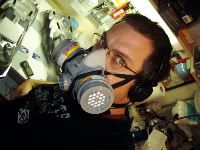Learning to weld can be both fun and rewarding. Let’s dive into what the newbie hobbyist welder needs to know to produce strong, safe, preferably good looking welds. In its most basic form, welding is the act of melting two pieces of metal and a filler material, joining them together, all the while protecting the molten metal from contamination from the air. This can be accomplished through several processes available to the hobbyist.
SMAW: Shielded Metal Arc Welding, aka arc welding or stick welding. A hand held clamp, sometimes called a stinger, is used to hold flux coated welding rods. As you weld, the rod burns away melting the base metals and the rod together. The flux coating on the rod is melted and it flows over the molten weld pool, protecting it from the air. The flux hardens over the weld and must be chipped off and wire brushed to remove it.
Pros: Different size and type of rods allows welding many different materials, material thicknesses, and positions. Easy to get good penetration. Can be used outdoors in windy conditions. Machines are relatively cheap and simple, no moving parts. Can weld dirty or rusty material.
Cons: Smokey, some weld splatter, requires chipping and cleaning of flux from welds.
GMAW: Gas Metal Arc Welding, aka MIG (Metal Inert Gas) welding or wire fed welding. With this process, a spool of solid wire is fed through the welding gun by rollers, where it melts on contact with the base metal, fusing them together. A separate bottle of an inert gas, typically a carbon dioxide and argon mix, is piped through the welding gun and covers the molten weld pool, shielding it from the air.
Pros: Easy to learn, no flux to chip and clean, easy to fill gaps in joints with poor fit up.
Cons: Cannot weld in windy conditions, typically only indoors. Moving parts occasionally get jammed; gun liners and tips need to be replaced occasionally. Easy to make a good looking, but weak weld with insufficient penetration. Must have inert gas bottle refilled by a welding shop.
FCAW: Flux Core Arc Welding aka flux core. A combination of MIG and SMAW. The mechanics are the same as a MIG: A spool of wire fed through the gun by rollers. However, instead of a shielding gas from a tank, the welding wire is hollow and flux is inside. Basically, an inside out SMAW rod. Like SMAW, the melted flux provides the shielding action for the molten weld puddle. Most MIG machines can be set up to weld with flux core wire.
Pros: Can be used in windy conditions, easy to get good penetration.
Cons: Smokey, some weld splatter, requires chipping and cleaning of flux from welds.
GTAW: Gas Tungsten Arc Welding, aka TIG (Tungsten Inert Gas) or Heliarc welding. This process uses a torch that a replaceable tungsten electrode is inserted after being sharpened to a point. The diameter of the tungsten is typically 1/16” to 1/8” of an inch. Unlike the other processes we have talked about, the tungsten electrode is not consumed while TIG welding. If additional filler metal is required to be added to the molten weld pool, it must be done by hand with a welding rod, similar to gas welding. Like MIG, a bottle of compressed inert gas is used to shield the weld pool. Argon is the typical inert gas of choice for TIG welding steel, stainless steel, and aluminum.
Pros: Clean, splatter free welds. Ability to weld exotic metals such as stainless steel, aluminum, titanium, and magnesium.
Cons: Requires great skill, coordination, and dexterity. You are simultaneously using one foot on a foot petal to control the heat output, one hand to hold the torch to control the electrode angle, arc length, and travel speed, and the other hand to feed in welding rod to the weld pool. Cannot be used in windy conditions, indoors only. Requires material to be extremely clean. Inert gas tanks have to be refilled periodically. Tungsten needs to be sharpened occasionally, or every time you contaminate by dipping it in the weld pool.
Oxy-Fuel welding aka gas welding. Uses a tank of a fuel, typically acetylene, and a tank of compressed oxygen. The fuel and oxidizer are mixed in the tip of the torch and lit on fire, producing a very hot flame. The flame is used to melt the base metals, and additional filler rod can be added by hand if necessary. Special tips can be installed for cutting steel or heating steel red hot for bending.
Pros: requires no electricity. Ability to cut relatively thick (around ½” for a basic setup) steel. Ability to heat, cut, and weld with one setup.
Cons: Very slow process. Requires skill and coordination similar, but a little easier than TIG welding. Tanks have to be filled periodically. Most hobbyists sets not suitable for welding thick material.
Your typical stick welder. Note it is very simple, a ground clamp, the electrode holder clamp, and a large knob to set the amperage.
Your typical MIG welder. Note the ground clamp and welding gun that the shielding gas and wire are fed through. Knobs set the amperage and wire speed.
Your typical gas welding setup. Note different tips for welding, cutting, or heating.




